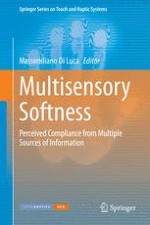2014 | OriginalPaper | Chapter
5. Computational Aspects of Softness Perception
Authors : Massimiliano Di Luca, Marc O. Ernst
Published in: Multisensory Softness
Publisher: Springer London
Activate our intelligent search to find suitable subject content or patents.
Select sections of text to find matching patents with Artificial Intelligence. powered by
Select sections of text to find additional relevant content using AI-assisted search. powered by
